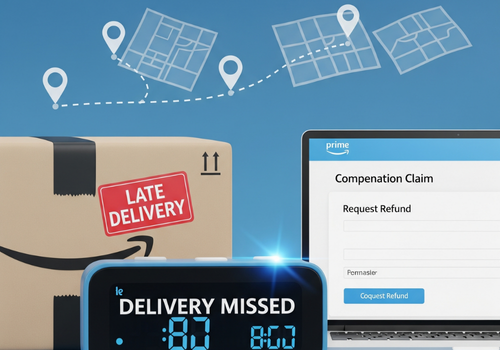Why Amazon Prime Delivery Is Slower Lately — Plus How to Get Compensation for Missed Promises, Is It Misleading?
Why Prime Delivery Is Slower in 2025 Than It Used to Be
Prime delivery delays are becoming more common due to a mix of logistical bottlenecks, regional warehouse shortages, labor constraints, and expanded shipping coverage. As Amazon continues to add new products, sellers, and fulfillment centers, the sheer volume of daily orders has stretched its delivery network. In some regions, especially rural or semi-urban areas, delivery timelines are affected by limited infrastructure. Additionally, weather events, seasonal spikes (like Prime Day and holidays), and a growing reliance on third-party carriers have all contributed to shipping slowdowns. What used to be a reliable 2-day guarantee now varies widely by location, product type, and even the seller.
The Fine Print: Prime’s 2-Day Shipping Promise Isn’t Always a Guarantee
Many customers still believe Prime’s 2-day shipping is a hard guarantee. But if you look at Amazon’s updated terms in 2025, the promise is now more of an estimate than a commitment. The “2-day shipping” clock starts when the product is ready to ship, not when you place the order. That means if a product is backordered, out of stock, or shipping from a remote warehouse, the actual delivery may be delayed. In addition, if you’re ordering from a third-party seller who fulfills their own products (not using FBA), Prime delivery doesn’t apply. These subtle disclaimers make the shipping timelines feel misleading to many users.
How to Check If You’re Eligible for a Delivery Refund or Compensation
If your Amazon Prime delivery was promised by a certain date and didn’t arrive on time, you may be eligible for a refund, Amazon credit, or even an extension of your Prime membership. First, go to “Your Orders” in your Amazon account and find the delayed order. Click on the order details to confirm the estimated delivery date versus the actual arrival date. If it was late, contact Amazon Customer Service via chat, phone, or email. Be polite but firm, mention that you’re a Prime member, and ask if you qualify for compensation due to the missed delivery promise. Amazon often responds with goodwill credits, discounts, or a one-month Prime extension.
Amazon’s Quiet Policy on Missed Delivery Compensation
Amazon doesn’t openly advertise its compensation policy for late Prime deliveries, but loyal shoppers who ask are often surprised at how accommodating the platform can be. In most cases, if you explain that your package was significantly delayed beyond the promised Prime window, you’ll receive a small gift card (usually £5–£10), a shipping refund, or Prime time extension. However, this is handled on a case-by-case basis and depends on your purchase history, delivery history, and how the support rep handles your request. Always have your order details ready and screenshots of the promised date if you’re requesting support through chat.
Third-Party Sellers and Prime Eligibility Confusion
One of the most misunderstood areas in 2025 is how third-party sellers affect Prime shipping. Just because a product is marked “Prime” doesn’t always mean Amazon is shipping it. Some sellers are eligible for Seller Fulfilled Prime (SFP), which means they manage their own shipping but promise Prime speeds. If those sellers don’t deliver on time, the responsibility technically falls on them — not Amazon. This adds confusion for buyers, as the lines between “Fulfilled by Amazon” and “Shipped by Seller” blur. Always double-check who the item is shipped and sold by when shopping if fast delivery is crucial.
Tips to Avoid Delivery Delays and Shop Smarter with Prime
To reduce the chance of experiencing late deliveries, prioritize products that are “Fulfilled by Amazon” instead of third-party sellers. Use filters to narrow search results and review expected delivery dates before checkout. Avoid placing high-priority orders during peak shopping seasons unless the product is clearly marked for next-day or 2-day delivery. If you need an item urgently, consider Amazon’s “Same-Day Delivery” option, now available in select cities, or choose the “Amazon Day” option for grouped deliveries. These strategies can help minimize delays and keep your experience closer to what Prime originally promised.
Is Amazon Being Misleading About Prime Delivery in 2025?
This is the question many consumers are now asking. While Amazon still markets Prime as a fast-shipping solution, the reality in 2025 is that speed depends on multiple variables. Many users feel misled when “2-day” estimates stretch into 4–5 days without explanation. With fewer warnings and shifting fine print, shoppers are starting to question whether they’re getting the full value from their paid membership. Transparency has become a growing concern, especially as Amazon raises its annual Prime fee while lowering the delivery consistency that made the service valuable in the first place.
Conclusion: Don’t Let Slower Prime Deliveries Go Unnoticed — Take Action
If you’ve experienced slower Amazon Prime deliveries recently, you’re not imagining things — delays are happening more often in 2025. Whether it’s due to warehouse constraints, third-party sellers, or shifting delivery policies, the speed you once relied on may no longer be guaranteed. But as a Prime member, you have the right to demand better. Always check your delivery promises, act quickly when an order is late, and don’t hesitate to request compensation. Holding Amazon accountable is the only way to ensure Prime remains a premium service — not just a paid subscription with broken promises. Stay informed, shop smart, and speak up.

